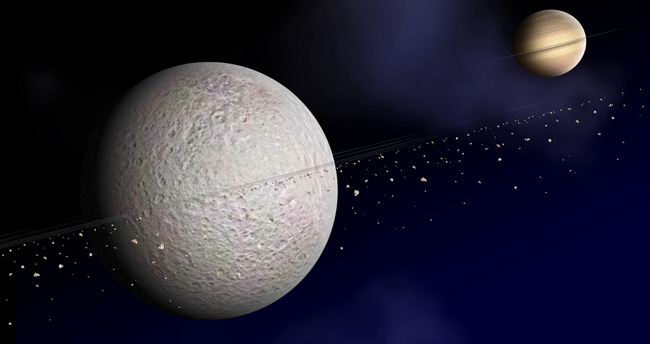Saturn's Moon Might Have Rings, Too

Saturn's moon Rhea could be a mini version of its ringedparent and the first moon known to have rings of its own.
Scientists detected hints of the rings when the Cassini spacecraft flew by the moon,Saturn's second largest, in November 2005.
Surprisingly, instruments aboard Cassini measured an absenceof electrons around the moon where astronomers expected the charged particlesto swarm.
"This showed that there was something unique goingon," said Geraint Jones, a Cassini scientist. "We haven’t seenanything like this at any of the other moons. The only thing we can come upwith that fits what we see is that maybe there is some debris around Rhea. Ifit is correct this would be the first moon where we have evidence ofrings."
Since Rhea lies within Saturn's magnetosphere, which trapsions and electrons, scientists expected the moon to be awash in theseparticles. Instead, they measured a gap in electrons in a swath of spacesurrounding Rhea.
A set of ringscould explain the disappearing electrons because the material making up therings — most likely chunks of water ice up to a centimeter or meter in diameter— would absorb electrons.
Rhea, named after the classical Greek titan goddess, themother of Zeus, Hades, Hera and other Olympian deities, is a barren, icy worldcovered in craters. Its diameter is a little less than half that of our moon.
Breaking space news, the latest updates on rocket launches, skywatching events and more!
So far, Cassini has not been able to see the rings. If thespacecraft's mission is extended, the researchers hope it might glimpse them ona future close flyby of Rhea.
Saturn has dozens of moons; to date, 52 of them have beennamed.
Before now, the Saturnian moons Enceladus,Titan and Iapetushave stolen most of the fame, Jones said. "Rhea seemed to be one of theleast interesting of the moons, but now it looks like it might be interestingfor its own special reasons," he told SPACE.com.
Jones and a team of Cassini scientists detail the findingsin the March 7 issue of the journal Science.
- Images:Cassini's Latest Discoveries
- Cassini'sGreatest Hits: The Best of Saturn
- Cassini Special Report

Clara Moskowitz is a science and space writer who joined the Space.com team in 2008 and served as Assistant Managing Editor from 2011 to 2013. Clara has a bachelor's degree in astronomy and physics from Wesleyan University, and a graduate certificate in science writing from the University of California, Santa Cruz. She covers everything from astronomy to human spaceflight and once aced a NASTAR suborbital spaceflight training program for space missions. Clara is currently Associate Editor of Scientific American. To see her latest project is, follow Clara on Twitter.
